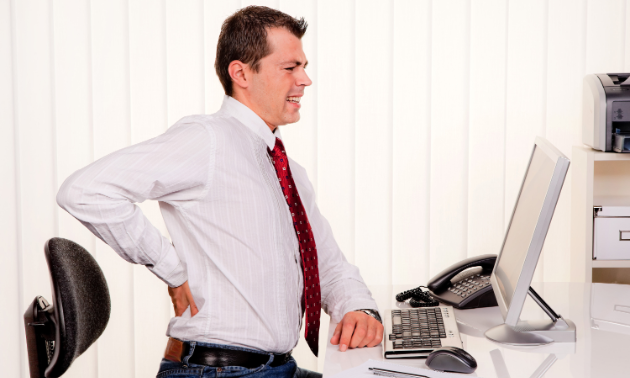Get back on track with these back-saving tips
Pain in the back? Here’s some insight to mount a counterattack

Taking breaks and moving throughout the day can help reduce strain on the body from being in the same position too long. — Can Stock photo
“Ow! My back!”
We’ve all been there. It can happen while playing a sport, lifting something heavy or even lying in bed. Maybe your back is sore while you sit and read this article right now. Fear not, dear reader, for a remedy is close at hand.
Andrew Burkholder is a physiotherapist at Creekside Physiotherapy and has seen his share of clients with back pain. Utilizing his wealth of knowledge, Burkholder shared some tips on how to keep your back in good condition. Straighten up and read on.

Andrew Burkholder is a physiotherapist at Creekside Physiotherapy. — Photo courtesy Kari Loftsgard
What’s the best way for office workers to take care of their backs?
Taking breaks and moving throughout the day can help reduce strain on the body from being in the same position too long. Going for a walk during your breaks, taking the stairs or doing stretches can help.
Make sure that your desk is set up correctly. There are some online sites for ergonomics that can be helpful to give you some guidance.
How do people most often injure their backs?
Repetition and unexpected or excessive movements are the most common causes of back injury.
Keeping active, maintaining your weight and watching your posture and positions can really help make a difference in preventing injury.
New or unaccustomed activities can lead to back injury as well. It is advisable when starting a new activity to start slowly and progressively. If you are unsure if your body is going to tolerate a new activity, it is advisable to get screened by a physiotherapist or kinesiologist to make sure you are safe to proceed. They can also give you exercises to help you prepare safely for the new activity. Progressing too quickly for the body to adapt (overload) is another common source of injury.
Where do most people experience back pain: lower back, mid-back or upper back?
Lower back pain is the most common type of back pain with roughly 85 per cent of people having an episode in their lifetimes. Additionally, 20 per cent of people between the ages of 20 and 60 have chronic lower back pain (pain lasting more than three months post-injury).
Seek help early if you have a problem. If your symptoms persist longer than two weeks, you should consider getting some help.
What’s the best remedy for back pain?
For acute or new back pain, it is best to move as much as you are able to without increasing the amount of irritation you are experiencing. This movement can include short walks as well as gentle stretching.
For chronic or long-term back pain, a combination of flexibility, core stabilization and aerobic activity is the best approach. The best research suggests that activity is the single most important thing you can do to reduce and prevent back pain.
Additional strategies include incorporating breathing and relaxation techniques such as those done in yoga.
Are there certain products that are useful and safe for back pain? Are there any that are unsafe or useless?
When considering alternative therapies, the best question to ask is: “Is there evidence to support the product or is it based on testimonials?”
Often, if a lot of promises are being made, it can be too good to be true.
Medication can help you manage your symptoms and therefore help you move better, so it is often a good idea to think of medication as moving medicine rather than pain medicine.
Are there any stretches or exercises that consistently help in preventing or alleviating back pain?
Start with walking regularly as a bare minimum. If you keep your trunk and hips mobile, your lower back will appreciate it.
What can people do when it comes to posture?
Even if you have perfect posture, no position is good for a long period of time. Our bodies need movement to supply nutrition to joints and tissues.






Comments